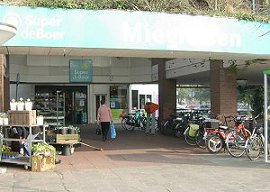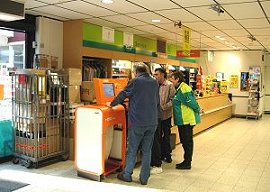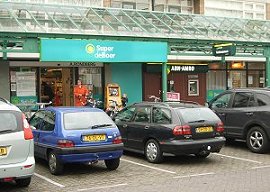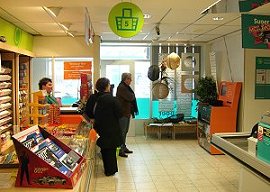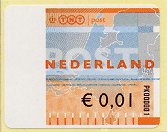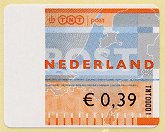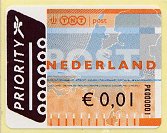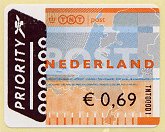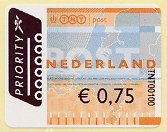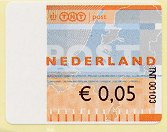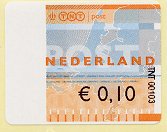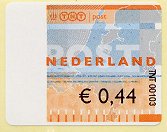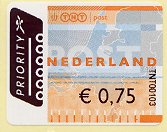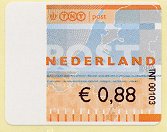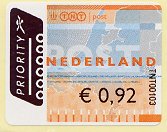| 2008.
The pilot trial of aCon for TNT
Post |
| In recent
years TNT Post has been revolutionizing the
classical concept of the post office, with new multi service
offices. The next step is to make the post offices even more
accessible to, and make them easier for, users. A model service that
will be keenly noted by the many worldwide postal
administrations. |
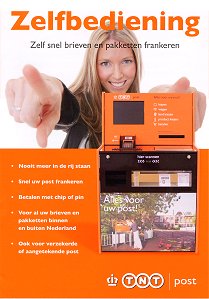 |
| New steps in the
TNT Postal strategy began in February
2008 with the installation of new self-service postal
kiosks at TNT Post Service Points (see article)
- small stands placed in non postal commercial establishments, where
the user can post letters and parcels, and buy some basic postal
products. |
| The
3 first machines were installed next to the
Service Points existing in the entrance area of 3
medium size supermarkets of the Dutch Super de
Boer retail chain. |
 |
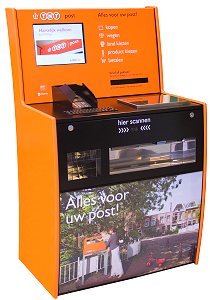 |
For
this pilot, TNT Post has chosen the
SPU (Self Post Unit), the
self-service postal kiosk manufactured by the Danish company
aCon. These kiosks have similar characteristics to
those already in service in Denmark (see article)
and Norway (see article),
although they are customized according to the specific requirements
of TNT Post and its company markings.
Through an
easy to use touch screen and a very simple and intuitive interface,
the user can select any of the following services (see also the screens
sequence):
1. Shipment of letters and parcels ... using the
scale.
2. Purchase of stamps (ATMs) with
different face values.
3. Purchase of parcel boxes.
Both
simple and registered mail options are catered for and the use of
the scales will result in the issue of ATMs of
various values.
As specified by TNT Post,
payment in these machines is only possible by local debit cards,
with PIN or Chip (Chipknip card), which does not present a
serious problem for the users, since it is in common use in
The Netherlands. |
The first
aCon - SPU postal kiosk, serial number
103, was installed on February 18th
2008 in the Roosendaal's Super de
Boer (Van Beethovenlaan 7 -right image-),
although it did not come into service until the next day,
February 19th, after the supermarket employees had
received training. As a new idea, the basic maintenance of these
machines is performed by the supermarket’s own employees, under
supervision by the Hytech company, the
aCon local partner in Holland. All
the aCon postal kiosks are connected to the
Internet and are monitored 24/7, which allows any anomaly in the
machines to be promptly noted, whilst small problems in the normal
daily use of the equipment could be solved on the spot.
During the first day, various news media visited the
Super de Boer to report the news. Both the
managers of the supermarkets and the employees in charge of the
maintenance, demonstrated a commitment to and an enthusiasm for the
new installation. |
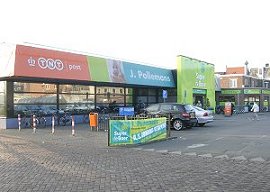 |
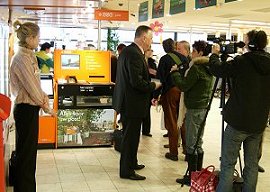 |
Following the same
procedure, the second SPU postal kiosk, number
100, came into service on February 20th
in the Breda's Super de Boer
(Donk 4)...
... and third one
on the following day, February 21st, in the
Ridderkerk's Super de Boer
(Dillenburgplein 5-11). The serial number is
101.
In the 3
instances, the aCon - SPU self-service postal
kiosks have been installed in the supermarkets entrance lobby, next
to existing TNT Post Service Points. These post
offices in miniature are currently fitted with a scale that allows
the issue of variable value stamps for immediate
use and sold by the supermarket’s own employees. The Service
Points are integrated into stands where the customers can
buy tobacco, lottery tickets and some postal products, (similar to
the Spanish 'estancos'), but where letters and parcels can
be posted.
|
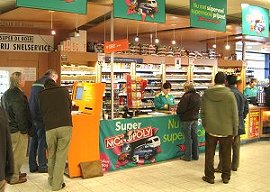 |
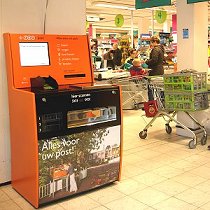 |
This
is an example of integration, exemplary in all its aspects. With
this new equipment in supermarkets, TNT Post wants
to make access to the postal services easier for users, so that they
will not have to move to the post offices, nor to wait in long
queues to be served, and in addition they will be able to manage
their postal needs in outside of office hours. At the same time,
they will simplify the work of the employees in charge of the stand,
as demonstrated by the considerable volume of mail posted daily from
this points. |
The presence of
a small group of specialist collectors, out to obtain the new
issues, showed, that at least for a day, how philately had entered
the supermarkets and this, naturally drew the attention of
non-collector customers, (the future users of the new postal
kiosks), to the services that the kiosks could
provide.
|
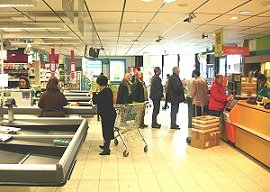 |
| The aCon
ATM issues for TNT Post |
For the ATM issue, the aCon -
SPU postal kiosks in The Netherlands use
identical rolls of self-adhesive labels to those used by the
ProPostal 2000 of Wincor Nixdorf -
NewVision (see article),
although differences in the thermal impressions made by both machines can
be recognized.
The face value is a larger size in the
ATMs issued by aCon equipment, whilst in
the case of ATMs for high-priority mail, the postal mark
is a smaller size. But perhaps the most obvious difference or
characteristic is the equipment number, printed
vertically to the right: The ProPostal 2000 postal kiosks
installed in Postkantoren has a number of
machines that start with the letters PK, whilst those
installed in TNT Post offices include the abbreviations
TNT and number from 00001, whereas the
aCon postal kiosks also begin with TNT,
but with numbers from 00100.
Roosendaal -
TNT00103
19/02/2008 |
Breda - TNT00100
20/02/2008 |
Ridderkerk -
TNT00101
21/02/2008 |
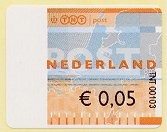 |
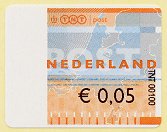 |
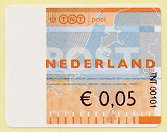 |
For collecting, if
the user selects the 'buy stamps' option in the main menu, the
aCon kiosks offers 6 face values;
2 make-up values and 4 for basic
franking. On the date of installation, these values are
0.05 and 0.10 EUR, 0.44
and 0.88 EUR (tariffs for inland letters up to 20 g., and
between 20 and 50 g., respectively), Priority 0.75 and
Priority 0.92 EUR (letters up to 20 g. to European
countries and rest of the world, by high-priority mail). The user can also
obtain ATMs with any other face value, from a minimum of
0.05 EUR.
Unlike the
ProPostal 2000 postal kiosks, that issues all the
ATMs cut one by one, the aCon machines
issues strips of 5 stamps, in case of multiple orders,
with the same value.
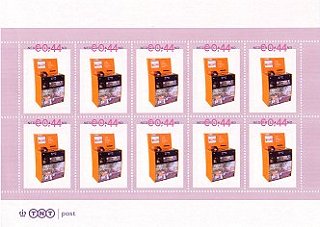 |
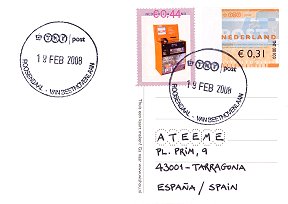 |
| Sheet of 10 personalized stamps
with the image of the aCon - SPU postal kiosk.
Customized postcard franked with one stamp and rest of franking with
an ATM issued by the same machine, first day
postmark |
 |
The aCon - SPU postal kiosks can also issue
self-adhesive postage labels with a bar code for the franking of
inland parcels (image below). For
international parcels, the machine issues an
ATM with the corresponding face value.
As
an improvement, compared with the ProPostal 2000
kiosks, the aCon also allows the shipment of
registered mail, both nationally and
internationally, and the corresponding stamp is also printed on one
of these large labels, which includes the face value. The first
image shows the upper part of a stamp for an inland registered
letter, whilst the middle one is for a registered letter to
Spain. |
 |
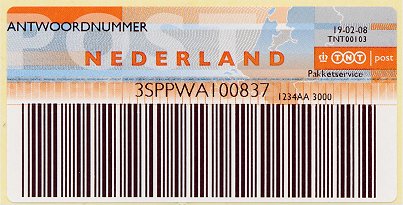 |
The various
receipts and slips are automatically printed after payment, on a large
size thermal paper in the Dutch language only. The buy-stamps operations
or the shipment of letters by normal mail generate a unique receipt,
detailing the list of products and the payment procedure. For shipments of
registered mail and parcels, the machine also prints a second slip with
the control or registration code. In the case of parcels posted to non- EU
countries, the customs declarations are also printed, perfectly
completed.
| Slip for the shipment of an inland parcel, with the control
code and the postal mark of the admission post office (down), and
receipt for a letter shipment to an European country, with the
detail of the payment operation by chipknip card
(right) |
 |
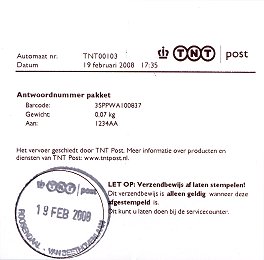 |
The aCon - SPU postal kiosks are fitted with a
colour touch screen. The user can select 2 languages: Dutch or
English.
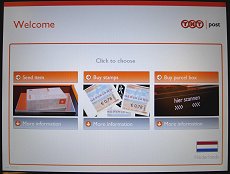 |
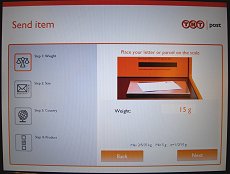 |
Welcome screen. The user can select 3 main options: To send a
letter or parcel, to buy stamps, or to buy a parcel box.
Selecting the option 'Send an item', the system asks the
user to place the letter or parcel on the scale. |
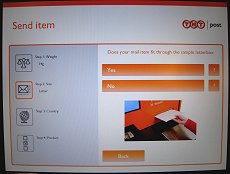 |
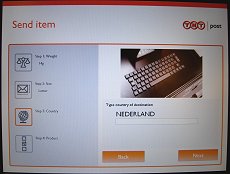 |
Once the weight of the shipment has been established, the
system determines if it is a standardized shipment and, next, the
destiny country.
In the next step, the equipment shows the
user the different types of shipment possible for the item, and the
corresponding postal tariff.
Selecting the option 'buy
stamps', the system displays the main current postal tariffs and
offers 6 different face values, as well as the possibility of
obtaining stamps with other values, by keying in the amount.
|
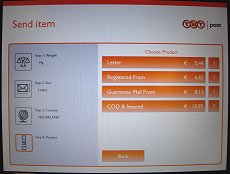 |
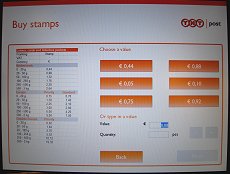 |
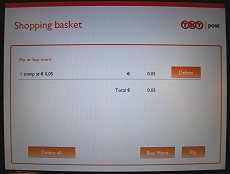 |
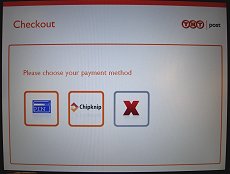 |
The
equipment shows the stamps or products selected by the user in a
'shopping basket' and, once the purchase is finalized, the payment
options available are displayed. |
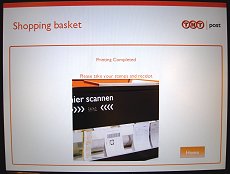 |
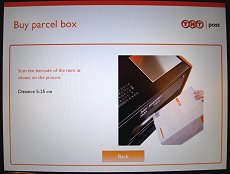 |
The
last screen reminds the user to take the stamps and
receipts.
The third option of the main menu allows for the
purchase of parcel boxes, using the scanner installed at the front
of the postal kiosk. |
You will be able to read this article also in VARIABLE 8 (edition
April 2008).
ATM Web - Spain and Latin
American Postal Services: http://www.ateeme.net/
© J. Jove - M. Sans.
ATEEME. Variable value stamps study group. All rights
reserved
This page was created in February 2008 and last updated:
15.03.08 . English edition
rewritten by S. Goodman (03.03.08) |






